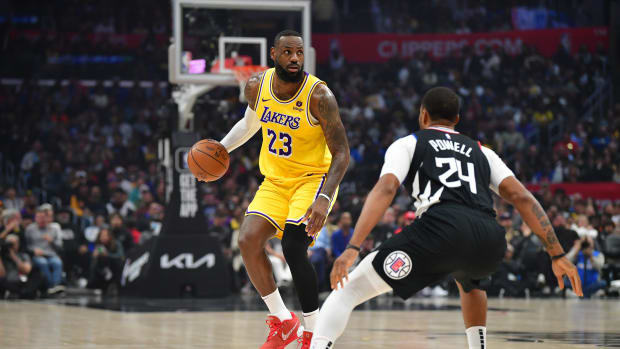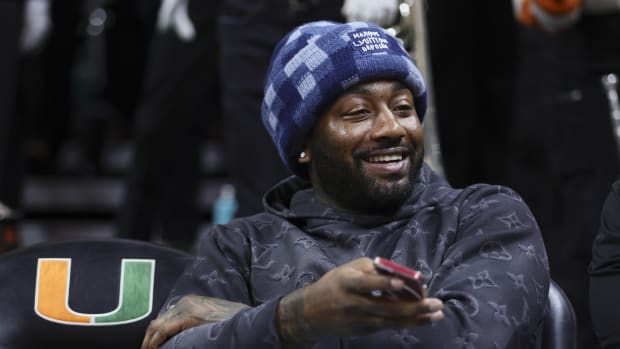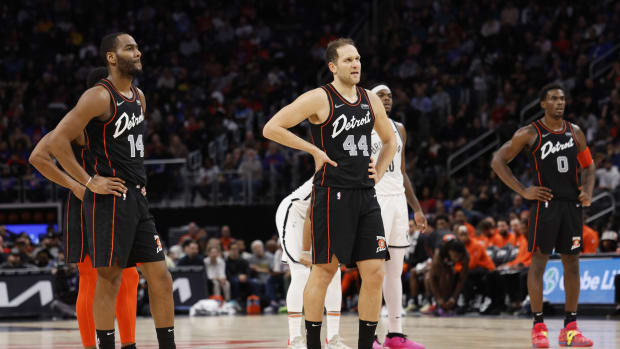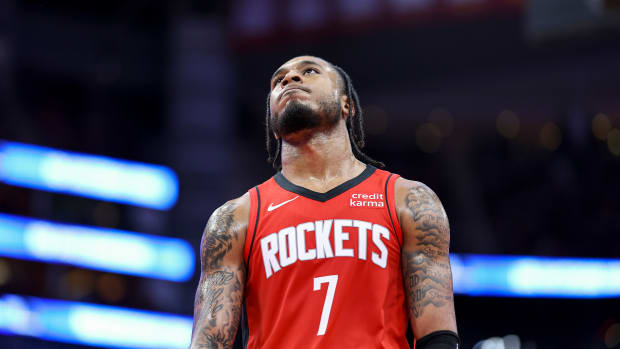The Evolution of Quentin Grimes
Whether you believe in this sort of thing, there is an alternate universe where Quentin Grimes is already two years into his NBA career, fulfilling the promise that felt like a foregone conclusion even before he started to collect just about every major award and accolade a high school player can receive. A Houston native, Grimes was the best his state had to offer, garnering the same type of recognition that was once earned by Chris Bosh, De’Aaron Fox and Marcus Smart.
Instead of struggling throughout his freshman season at the University of Kansas, where he was unable to fold his immense talent into Bill Self’s meticulous offensive system, in this imaginary universe Grimes actually was “probably as complete a guard as we’ve ever had,” which is something Self really said before Grimes played his first college game.
A quick leap into the NBA is what many expected three years ago, when Grimes was a five-star recruit drawing favorable comparisons to several intriguing building blocks—including Tyler Herro, Coby White and Darius Garland—who came from the same high school class. Now he’s 21 years old with two separate college basketball stints under his belt, the most recent ending at the Final Four as the University of Houston’s best player. Grimes is no longer a prodigious lottery pick, but after seeing his potential nearly go up in flames his freshman year, he’s resuscitated his value as the exact type of player every NBA team would love to have.
“[At Kansas] I was looking too far ahead instead of just taking it day by day, and that’s kind of what got me off-track, probably,” Grimes says. “Saying, ‘I’ll be here for like three more months, and then I’m out.’ ”
Some of the steadiest NBA existences are preceded by a circuitous route, one full of humbling setbacks that force introspection and accountability. Had Grimes not stumbled at Kansas, he would not have transferred to Houston. Had he not transferred to Houston, he in all likelihood would not be the well-rounded, versatile cog he’s become: a smooth three-point-shooting wing who sinks his teeth into defensive possessions. The stars aligned at his second collegiate stop, where Grimes’s veneer was stripped away by a coach who is equally hard on all his players.
“We needed his talent, but he needed what our program’s culture was about. And that was being hard-nosed, being tough, defending and rebounding.” Houston head coach Kelvin Sampson says. “I think Quentin always thought that was for the [peons]. That’s for the regular guys. I’m a star. I don’t need rebounding. But in our program, my man, if you don’t get on them boards …”
When Grimes didn’t rebound like he was supposed to, Sampson made the entire team run while his most talented player stood to the side and watched. Those punishments were ultimately few and far between. “That’s why I think the good lord put that boy in our program,” he says.
Not only did Grimes lead the American Athletic Conference in total points—while finishing first in offensive and defensive wins shares, fifth overall in the country—but only two players grabbed more rebounds than the 6' 5", 210-pound wing. He was also second in his conference in steals and one of three players nationally who canned at least 100 threes.
At Kansas, Grimes averaged 8.4 points per game and shot 38.4% from the floor. Self’s disappointment spilled into press conferences, and Grimes often watched crunch-time action from the bench. From that first year in Kansas to his junior season with the Cougars, Grimes’s PER nearly tripled. But numbers don’t really do justice to how different these two players look when you watch the film side by side. On the Jayhawks, Grimes was fidgety. The quickness was there, but it was rarely harnessed with a purpose. He shot just 44% at the basket, or about 20% below what the NBA average was this season.
The struggle was amplified in rare instances when he found himself playing off a ball screen or in isolation. According to Synergy Sports, Grimes finished 3-for-21 scoring out of the pick-and-roll and 4-for-12 in iso situations. That production for an entire season totaled 18 points.
“It probably just wasn’t the best fit for my game and my style, personally. The first game I had six threes, but before that I probably had some bad practices and everybody just saw the game,” he says. “I feel like everybody who kind of knew my game and knew me coming up, they just knew that I couldn’t really flourish in that system.”
Grimes then attended the 2019 NBA combine and learned that teams saw him as a late second-round pick. “I wanted to be able to come into the draft and show people who I really was,” he says. “Like, the player I was coming out of high school.”
When Sampson watched Grimes play he didn’t see the type of confidence players with that much talent typically have. “For a kid that had his résumé coming out of high school, most of those kids just have crazy swagger. There’s mojo about them. I’ve had kids like that,” Sampson says, recalling his days with Eric Gordon at Indiana.
“Eric knew he was the best player on the floor and he played like it. I didn’t see that with Quentin. He wasn’t a pick-and-roll guy, wasn’t a rebounder, was kind of a passive defender. All he knew how to do was score. But he wasn’t scoring within the team. So there was a lot of things we had to fix with him.”
Their relationship got off the ground in 2019, when Sampson was sitting on an airplane with his wife, when he received a long text message from James Harden, whom he knew from his time as an assistant with the Rockets. Harden was visiting Arizona State’s campus in Phoenix and had just watched Grimes during a workout. “‘Coach Kel, this boy is ready to go,’” Sampson remembers Harden’s text. “‘He’s a pro. He was the best player on the floor today.’ That’s when I knew that we had to get him.”
At the same time, Harden told Grimes that Houston was the place for him. “He asked me what are some of the schools that you’re looking to transfer to, and I told him University of Houston,” Grimes says. “So he was like, ‘[Sampson] can be super hard on you, but he’s gonna let you rock out and he’s gonna let you do your thing.’ Once I heard that, it was kinda like a no-brainer.”
With help from Self, who lobbied the NCAA for a transfer waiver on Grimes’s behalf after Kansas expected him to stay in the draft and filled his scholarship spot with another player, he avoided sitting out an entire season after transferring. Flash forward to his second year at Houston where, according to Synergy Sports, Grimes finished in the 86th percentile as a pick-and-roll ballhandler and made 4o.3% of the 8.3 threes he launched per game. And still, despite obvious signs of someone who could immediately help just about any team in the league, Grimes was overlooked on most mock drafts, some of which left his name off the top 60 altogether.
He is not much of an inside scorer and had 59 assists to 55 turnovers last year. That, combined with his relatively stale appeal as someone who’s been on NBA radars for much longer than most others in this field, hurt his stock even after the bounce-back second season at Houston.
“It’s like a great fielding, no-hit shortstop,” Sampson said. “Now, he may hit .300 for three years and you’ll still call him a great fielding, no-hit shortstop because that’s what he was. I think the Kansas experience and the bottoming out there, and then struggling a little bit his first year here, a lot of people had a hard time getting over that.”
As someone who, through his career, has seen his name floated from a top-five pick to an undrafted afterthought, Grimes doesn’t pay much attention to prognosticators.
“[My agent] was like, ‘Don’t even look at the mock drafts because trust me, you’re really high on everybody’s list.’ So once you hear that from your agent and get that firsthand information from the teams he’s calling, that made it easier for me to not worry about it, because there’s so much politics that go into those type of things,” Grimes says. “That stuff, it’s just your name on a screen. You’re working for your name to get called, not to see how high your name is two months before the draft.”
A dominant showing at the 2021 combine shifted some of that perception, though. Grimes scored a high 39 points in 50 minutes of five-on-five action. Afterward, praise poured in. Sports Illustrated’s Jeremy Woo wrote that “Grimes was arguably the best player in the on-court portion of the combine,” while ESPN’s Jonathan Givony and Mike Schmitz noted that NBA executives were “very enthusiastic about Grimes’ showing, as he appeared to have moved himself from a potential second-round pick to a strong first-round candidate.”
Having already been on their radar for years, teams already knew who Grimes was before he arrived at the combine in Chicago. They’d already done background checks, conducted interviews and were familiar with his strengths and weaknesses. But eyes were still opened.
“I was overprepared, really,” Grimes says. “My mindset was I was gonna go out there and play as hard as I could for as long as I could and show everybody the type of player I am, just kind of remind them that I’m one of the best players in this draft, and I feel like that’s what I did.”
Before the combine and through the weeks leading up to the draft, when he wasn’t traveling the country for workouts with different NBA teams, Grimes’s home base was Memphis, where he spent umpteen hours in the gym with Penny Hardaway. The two primarily focused on playmaking skills that were undeveloped throughout his college career.
“The way [Hardaway] sees the game is completely different. It’s just crazy, his IQ,” Grimes says. “Coming off screens he’s just like, ‘That big man is gonna be back, if he’s reaching go around him, if he’s back, just pull up and shoot.’ So it's just the little things, coming off screens, how tight it is.”
On the subject of what Grimes can or should be in the NBA, there are two schools of thought and both are to his benefit. The first is based on feasibility: a complementary wing who can make threes and guard multiple positions. Sturdy, plug-and-play, able to compete during the fourth quarter of a playoff game.
This projection comes with no pretense. It’s what NBA teams envision Grimes being when they talk to Sampson. The role is useful, practical and increasingly important; it also reminds Sampson of the draft meetings he used to sit in when he worked for the Spurs. Their architect, R.C. Buford, would always ask his scouts how, specifically, the prospect in question impacted winning.
At the same time, Sampson believes any part that stifles Grimes’s talent may sell his star short, a fascinating, mild dilemma that applies to a healthy crop of NBA hopefuls in every draft since the league went small while prioritizing the three-point shot.
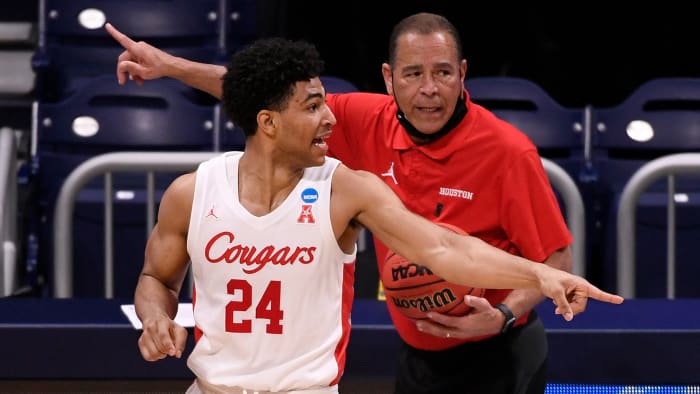
Under Sampson, Grimes developed his all-around game, including rebounding and defense.
Doug McSchooler/USA TODAY Sports
“He’s not a three-and-D guy,” Sampson says right before he lists all the games where Grimes’s ability to take and make difficult shots saved Houston from a loss. “To me, early in his NBA career, [he’s] going to be a scorer on the second unit. They’re going to find out very quickly that he can … light that scoreboard up in a hurry.”
Grimes agrees, to a point. He also understands how his range and defensive versatility have turned him into a commodity that any team picking late in the first round that has big goals (like the Sixers, Jazz, Nets, Nuggets or Clippers) could’ve used in the playoffs. “I think people kinda label me as [three-and-D] right now because of how well I’ve been shooting the ball and how well I guard the ball,” he says. “But I feel like coming out of high school it was like the complete opposite. ‘He doesn't shoot that well. He’s athletic, gets to the rim,’ so it’s crazy to see the flip side.
“I’m definitely a playmaker for sure who can shoot the ball off the dribble, off the catch, can make plays for myself and I feel like I’m a really underrated passer. So I definitely don’t feel like I'll be a 3-and-D for too long. I think that’s just the label that people have kinda made for me right now.”
As he watched the NBA playoffs, Grimes—who’s the exact same size as Devin Booker—saw what he can eventually be in Hawks guard Bogdan Bogdanović, a similarly sized, self-sufficient shot creator who competes on the other end. According to Synergy Sports, Grimes finished his junior season in the 83rd percentile on “guarded” jump shots. “Some guys, if they’re wide open they can make it. Quentin can make those, but he is elite with a hand in his face,” Sampson says.
The draft is less about where you’re selected and more about how mutually beneficial the situation is that you’re dropped into. Even if Grimes had a better freshman season and found himself getting selected by a team that needed him to blossom into a high-usage ballhandler, said team would’ve most likely been pretty bad. Instead, as a more mature player and person, he’s more likely to land somewhere stable.
“If I’m coming in after a really successful freshman year, I feel like there might be a lot of holes in [my] game that I wasn’t able to work on and correct,” Grimes says. “I feel like this path was the best option for me, really, just working on everything: shooting, defense, being a lot more sharper mentally to go through that adversity that I went through at Kansas and coming out better on the other side.”
Sampson puts it another way: “That kid that left Kansas, that guy’s in the witness protection program somewhere. This guy? Everybody knows who he is. The more you see him play, the more you realize that all that luster and all those accolades he was getting in high school, he was getting that for a reason. Now he’s become the player we all thought he would be.”
More NBA Coverage:
• Mock Draft 6.0: Dust Settles on Top Three
• Ranking the Top 50 Free Agents
• The Bucks' Long Game Pays Off































